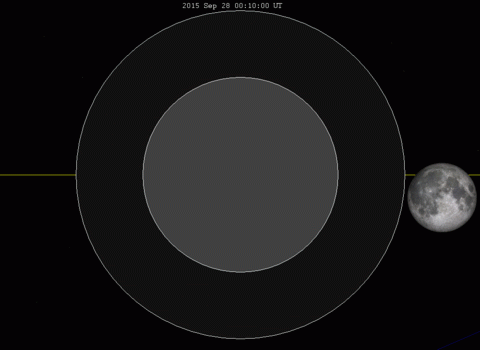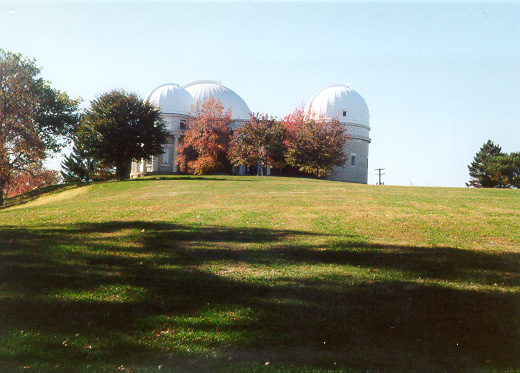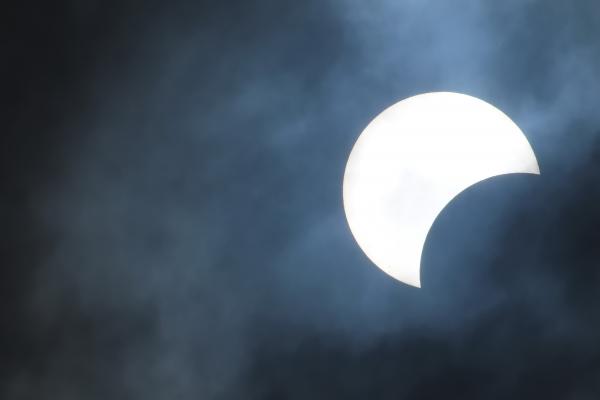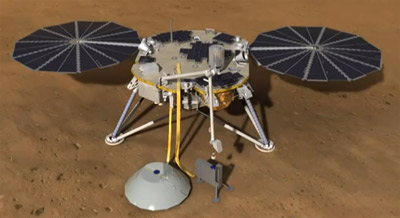
This simulation shows the approximate appearance of the Moon passing through Earth's shadow for tonight's Total Eclipse of the Moon. The Moon's brightness is exaggerated within the umbral shadow. The northern portion of the Moon was closest to the center of the shadow, making it darkest, and most red in appearance. (Image Source: Wikipedia.org )
By Glenn A. Walsh
Reporting for SpaceWatchtower
TONIGHT, the fourth and final Total
Eclipse of the Moon, of the current Tetrad of total lunar eclipses
will be visible throughout America, WEATHER-PERMITTING. The eastern
half of America will see the entire eclipse, while the western half
of America will see the eclipse in-progress, as the Moon rises in
their area.
For areas where the weather is not
cooperating, there will be Internet web-casts available for anyone to
watch. Internet links to these web-casts are at the end of this blog
post.
The eclipse event actually begins on
Sunday evening at 8:11:46 p.m. Eastern Daylight Saving Time (EDT) /
Monday at 0:11:46 Coordinated Universal Time (UTC) as the Moon enters
the dim penumbral shadow of the Earth. This will result in a slight
dimming of the light coming from the Moon, which not everyone will be
able to notice. Everyone watching will be able to see the Moon
entering the Earth's umbral shadow, at 9:07:12 p.m. EDT (Sept. 27) /
1:07:12 UTC (Sept. 28), as the Partial Lunar Eclipse phase begins.
A Lunar Eclipse or Eclipse of the Moon
is when the orbit of the Moon brings our natural satellite into the
Earth's shadow, always near the time, and including the time, of a
Full Moon. Hence, when the Sun, Earth, and Moon are in such a
near-perfect alignment, it is known as a syzygy. As the Moon's orbit
.around the Earth is slightly tilted, with respect to the Earth's
orbit around the Sun, such an alignment does not occur most of the
time, when the Moon passes above or below the Earth's shadow.
An Eclipse of the Moon or Lunar
Eclipse is the type of eclipse that is safe to watch, directly, with
the naked-eye, binoculars, or a telescope. Of course, visibility
is dependent on local weather conditions. For areas where sky
conditions are poor, as well as in areas where the eclipse will not
be visible at all, Internet web-casts of the event will be available
(links to these web-casts are listed near the end of this blog post).
This will be the fourth and final Total
Lunar Eclipse, in a Tetrad of four successive total eclipses of the
Moon, within a span of two years, with no partial lunar eclipses
occurring within those two years. The dates of the other three Total
Lunar Eclipses of the current Tetrad are 2014 April 15, 2014 October
8, and 2015 April 4.
Lunar Eclipse Tetrads are sporadic and
usually rare. There were no such Tetrads during the 300-year period
of 1600 to 1900. However, this is the first of eight Tetrads
in the 21st Century! The next Tetrad will begin in April of 2032.
Some Christian ministers have proposed
that this particular Tetrad may fulfill a "Blood Moon”
prophecy of the end-times, while others including Mike Moore, the
then-General Secretary of Christian Witness to Israel (in January of
2014), discount such a prophecy.
Tonight's Tetrad Total Lunar Eclipse is
a so-called “Super Moon,” a perigee Full Moon caused by the
closest approach of the Moon to the Earth in 2015: 356,877
kilometers. Hence, tonight's Full Moon will look a little bit larger
than any other Full Moon this year, particularly near the horizon
during Moon rise and Moon set (actually, the Moon always looks a
little bigger during Moon rise and Moon set, as a person's vision
then compares the size of the Moon to other objects near the
horizon). . And, as with many such perigee full moons, very large tides are predicted along ocean
coastlines for about a 24-hour period.
The Full Moon of tonight's Tetrad Total
Lunar Eclipse is also the Harvest Moon for 2015. The Harvest Moon is
the Full Moon closest to the Autumnal Equinox, the official beginning
of Autumn or Fall, which occurred on September 23. As hours of
sunlight become shorter, and temperatures became cooler, farmers would be
rushing to harvest all of their crops. The days around the Harvest
Moon would give them, and their workers, additional light in the
evening to finish harvesting their crops.
The Harvest Moon, in general, can occur
from two weeks before the Autumnal Equinox to two weeks after the
beginning of Fall. When the October Full Moon occurs early in the
month, it is then sometimes considered the Harvest Moon. The October
Full Moon, which is usually the first Full Moon after the Harvest
Moon, is usually considered the Hunter's Moon, providing hunters with
additional light to hunt game after sunset. When the October Full
Moon is considered the Harvest Moon, some still consider it the
Hunter's Moon as well, while others then consider the November Full
Moon the Hunter's Moon. The Harvest Moon has the same characteristics
in the Southern Hemisphere, when it occurs in March or April.
In the Northern Hemisphere, the
September Full Moon is also known as the Corn Moon, Fruit Moon, Wild
Rice Moon, and Red Plum Moon.
The September Full Moon has been given several names in the Southern Hemisphere: Worm Moon, Lenten Moon, Crow Moon, Sugar Moon, Chaste Moon, and Sap Moon.
The September Full Moon has been given several names in the Southern Hemisphere: Worm Moon, Lenten Moon, Crow Moon, Sugar Moon, Chaste Moon, and Sap Moon.
Here are the major stages of the
eclipse --- Sunday Evening to Monday Morning, 2015 September 27 to 28
(EDT: Eastern Daylight Saving Time / UTC: Coordinated Universal Time)
---
September 27 / September 28
Penumbral Lunar Eclipse Begins –
ECLIPSE BEGINS 8:11:46 p.m. EDT / 0:11:46 UTC
Partial Lunar Eclipse Begins 9:07:12 p.m. EDT / 1:07:12 UTC
Lunar Perigee (356,877
kilometers) 10:00 p.m. EDT / 2:00 UTC
Total Lunar Eclipse Begins 10:11:11
p.m. EDT / 2:11:11 UTC
Greatest Lunar Eclipse 10:47:09.1
p.m. EDT / 2:47:09.1 UTC
Moon Phase - Full Moon 10:51
p.m. EDT / 2:51 UTC
Total Lunar Eclipse Ends 11:23:07
p.m. EDT / 3:23:07 UTC
September 28 / September 28
Partial Lunar Eclipse Ends 12:27:06
a.m. EDT / 4:27:06 UTC
Penumbral Lunar Eclipse Ends –
ECLIPSE ENDS 1:22:33 a.m. EDT / 5:22:33 UTC
Internet Web-Casts of the September 27 to 28 Total Eclipse of the Moon ---
Internet Web-Casts of the September 27 to 28 Total Eclipse of the Moon ---
NASA - Begins Sept. 27, 8:00 p.m. EDT / Sept. 28, 0:00 UTC:
Sky & Telescope Magazine - Begins Sept. 27, 9:00 p.m. EDT / Sept. 28, 1:00 UTC:
Link >>> http://www.skyandtelescope.com/astronomy-news/observing-news/watch-this-months-lunar-eclipse-live-090320155/
Griffith Observatory, Los Angeles - Begins Sept. 27, 9:30 p.m. EDT / Sept. 28, 1:30 UTC:
Griffith Observatory, Los Angeles - Begins Sept. 27, 9:30 p.m. EDT / Sept. 28, 1:30 UTC:
Link >>> http://livestream.com/GriffithObservatoryTV/LunarEclipseSep2015
Slooh Community Observatory - Begins Sept. 27, 8:00 p.m. EDT / Sept. 28, 0:00 UTC:
Link >>> http://live.slooh.com/stadium/live/mega-harvest-moon-eclipse?utm_source=ealert&utm_medium=email&utm_campaign=MegaMoonEclipse
Slooh Community Observatory - Begins Sept. 27, 8:00 p.m. EDT / Sept. 28, 0:00 UTC:
Link >>> http://live.slooh.com/stadium/live/mega-harvest-moon-eclipse?utm_source=ealert&utm_medium=email&utm_campaign=MegaMoonEclipse
NASA Science News: Total Eclipse of the Harvest Moon:
Link >>> http://science.nasa.gov/science-news/science-at-nasa/2015/22sep_lunareclipse/
How to Photograph this Lunar Eclipse:
Link >>> http://news.yahoo.com/photograph-supermoon-total-lunar-eclipse-124219764.html
More on the so-called "SuperMoon": Link >>> http://en.wikipedia.org/wiki/Supermoon
More on the Full Moon: Link >>> http://en.wikipedia.org/wiki/Full_moon
More on Full Moon names ---
Link 1 >>>
http://www.farmersalmanac.com/full-moon-names/
Link 2 >>> http://earthsky.org/astronomy-essentials/full-moon-names
Link 3 >>> https://en.wikipedia.org/wiki/Full_moon#Harvest_and_hunter.27s_moons
Link 2 >>> http://earthsky.org/astronomy-essentials/full-moon-names
Link 3 >>> https://en.wikipedia.org/wiki/Full_moon#Harvest_and_hunter.27s_moons
More on the “Blood Moon” prophecy
of the end-times:
Related Blog Posts ---
"Early Sat. Morning Lunar Eclipse w/ Web-Casts." 2015 April 4.
Link >>> http://spacewatchtower.blogspot.com/2015/04/early-sat-morning-lunar-eclipse-w-web.html
"Colorful, Early Wed. Morning Lunar Eclipse w/ Web-Casts." 2014 Oct. 8.
Link >>> http://spacewatchtower.blogspot.com/2014/10/colorful-early-wed-morning-lunar-eclipse.html
Total Lunar Eclipse Early Tue. Morning w/ Web-Cast." 2014 April 14.
Link >>> http://spacewatchtower.blogspot.com/2014/04/total-lunar-eclipse-early-tue-morning.html
U.S. to See 4 Total Lunar Eclipses in Year & A-Half." 2014 March 29.
Link >>> http://spacewatchtower.blogspot.com/2014/03/us-to-see-4-total-lunar-eclipses-in.html
Source: Glenn A. Walsh Reporting for SpaceWatchtower, a project of Friends of the Zeiss.
Want to receive SpaceWatchtower blog posts in your inbox ?
Send request to < spacewatchtower@planetarium.cc >..
gaw
Glenn A. Walsh, Project Director,
Friends of the Zeiss < http://buhlplanetarium.tripod.com/fotz/ >
Electronic Mail - < gawalsh@planetarium.cc >
SpaceWatchtower Blog: < http://spacewatchtower.blogspot.com/ >
Also see: South Hills Backyard Astronomers Blog: < http://shbastronomers.blogspot.com/ >
Barnestormin: Writing, Essays, Pgh. News, & More: < http://www.barnestormin.blogspot.com/ >
About the SpaceWatchtower Editor / Author: < http://buhlplanetarium2.tripod.com/weblog/spacewatchtower/gaw/ >
SPACE & SCIENCE NEWS, ASTRONOMICAL CALENDAR:
< http://buhlplanetarium.tripod.
Twitter: < https://twitter.com/spacewatchtower >
Facebook: < http://www.facebook.com/pages/
Author of History Web Sites on the Internet --
* Buhl Planetarium, Pittsburgh:
< http://www.planetarium.
* Adler Planetarium, Chicago:
< http://adlerplanetarium.
* Astronomer, Educator, Optician John A. Brashear:
< http://johnbrashear.tripod.com >
* Andrew Carnegie & Carnegie Libraries:
< http://www.andrewcarnegie.
* Civil War Museum of Andrew Carnegie Free Library:
< http://garespypost.tripod.com >
* Duquesne Incline cable-car railway, Pittsburgh:
< http://inclinedplane.tripod.
* Public Transit:
< http://andrewcarnegie2.tripod.





